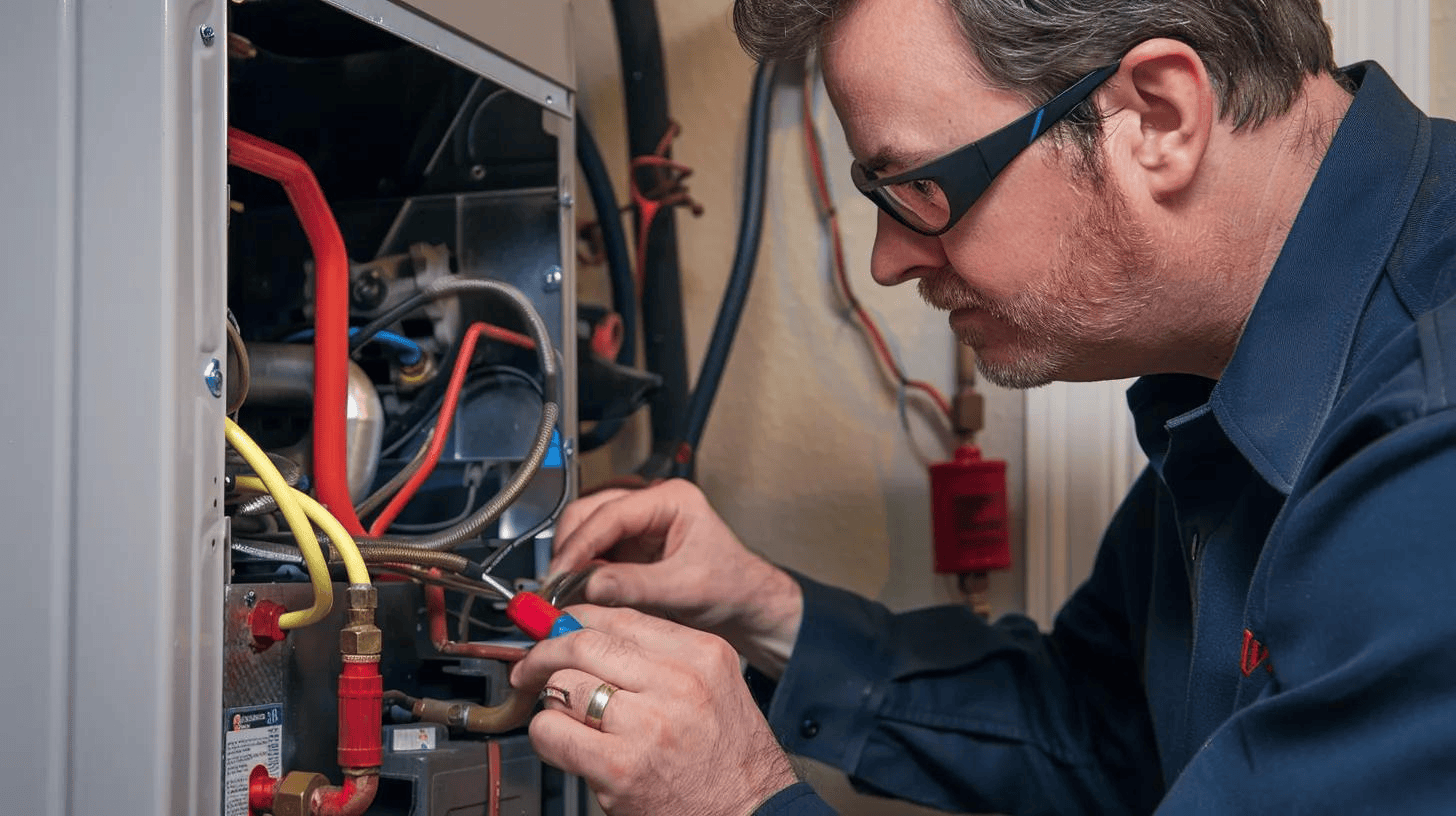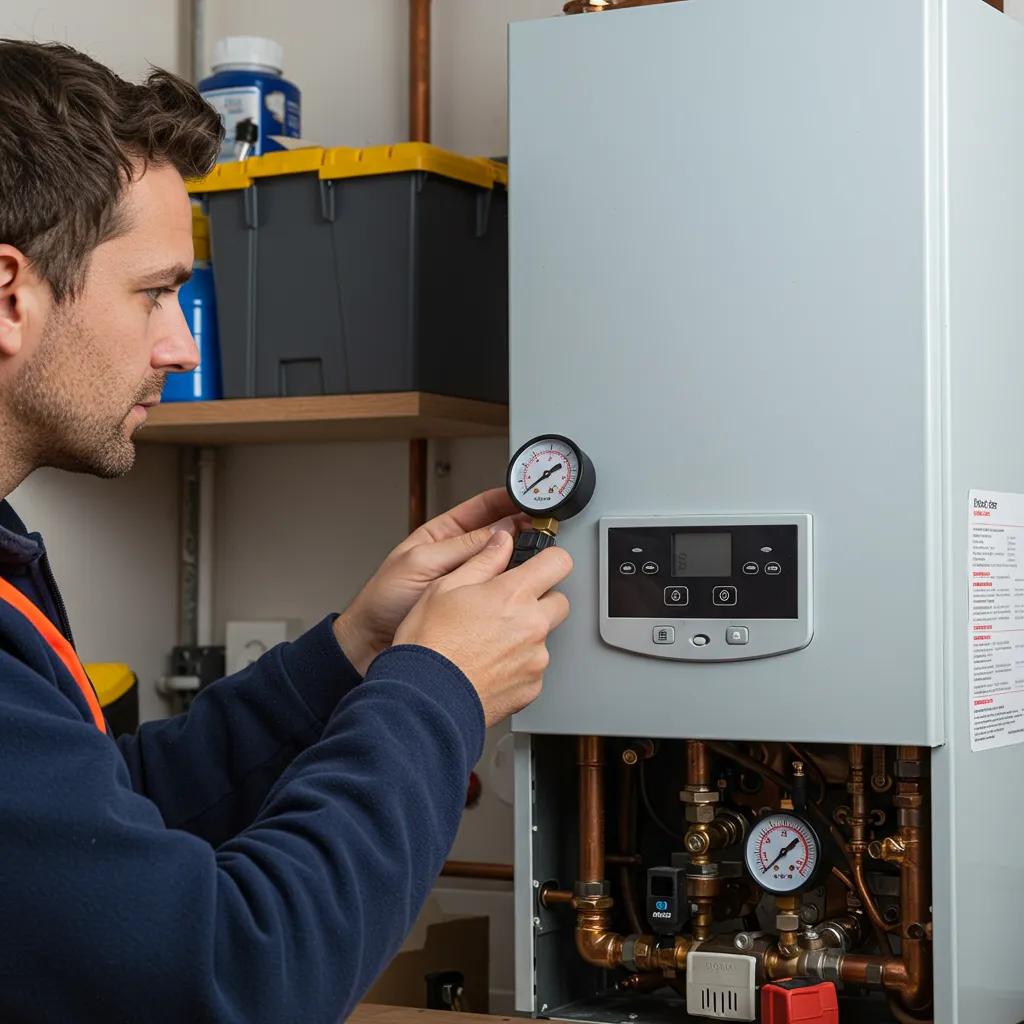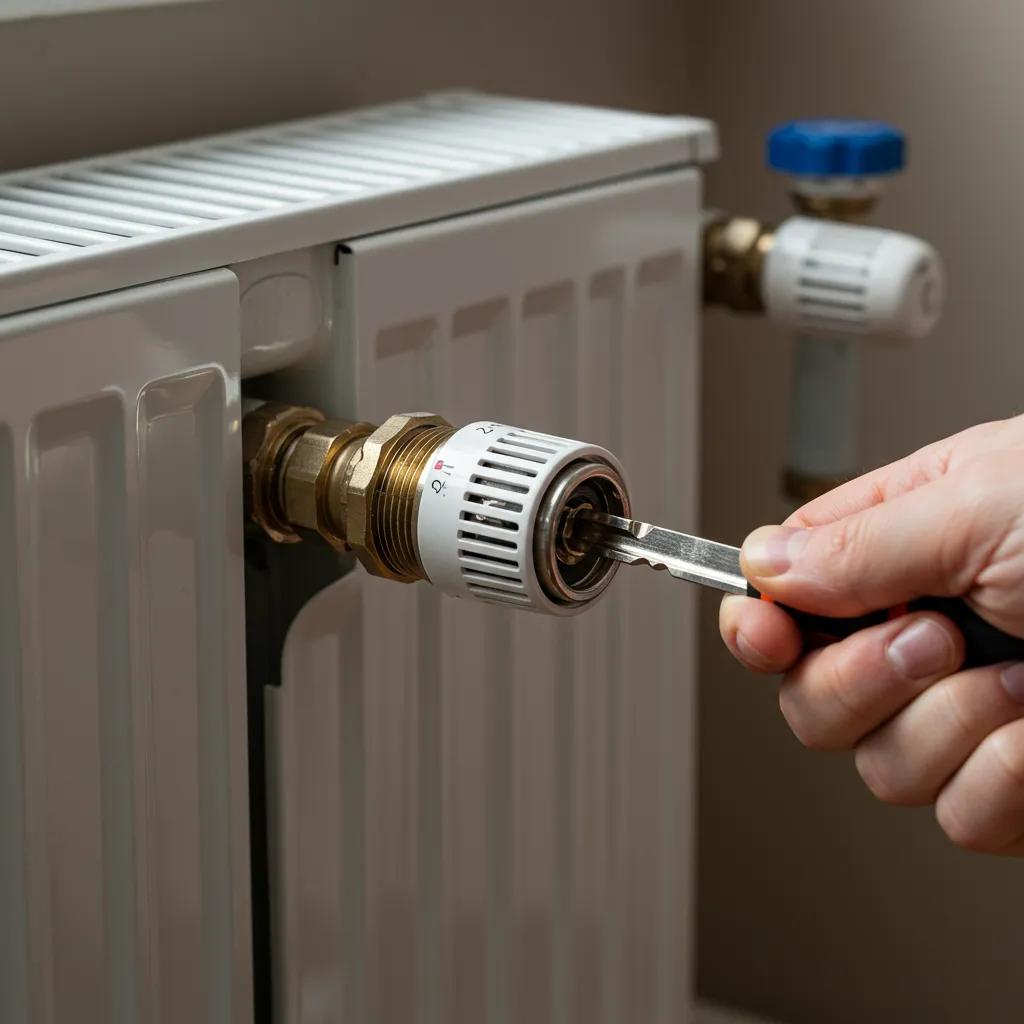
Common Heating System Problems and Solutions: How to Diagnose and Fix Heating Issues
Heating systems—whether boilers, furnaces, radiators, or heat pumps—keep homes and small businesses safe and comfortable. Diagnosing faults early prevents discomfort, damage, and wasted energy. This article explains common heating system problems and solutions, showing how faults occur, how to run safe DIY checks, and when a technician should be contacted for professional repair. You will learn practical furnace troubleshooting, boiler repressurization steps, radiator bleeding and balancing methods, thermostat fault checks, leak detection tactics, and maintenance actions tailored to Arizona conditions. The guide maps symptoms to quick fixes and decision points, offers compact tables for fast diagnosis, and highlights when same-day or specialist Heating Services are appropriate. Read on for focused, actionable advice on heaters, boilers, radiators, thermostats, and heat pumps, with clear steps to restore warmth and efficiency.
Why Is My Boiler Not Heating Up? Causes and Fixes Explained
A boiler that won’t heat typically fails to transfer energy because of electrical faults, ignition issues, low pressure, or circulation problems; identifying the root cause requires checking power, pressure, and visible faults first. The mechanism often involves interruption in fuel/ignition, blocked flow from airlocks or limescale, or failure of controls such as thermostats and pumps, which prevents heat reaching radiators. Resolving many common boiler faults improves comfort and reduces risk, while professional repair restores reliability and addresses safety concerns. The following subsections break down likely reasons, step-by-step troubleshooting, and clear indicators for calling a professional, so you can act quickly and safely.
What Are the Common Reasons for a Boiler Not Heating?
Common causes of a cold boiler include loss of electrical supply, failed ignition or pilot, low system pressure, and circulation faults such as pump or valve failure. Electrical issues often show as a blank display or tripped breaker, while ignition faults produce error codes or repeated lockouts; low pressure is visible on the gauge and often follows a leak or recent maintenance. Limescale and airlocks reduce flow, producing cold radiators or hot spots despite the boiler running, and worn pumps or seized components stop circulation entirely. Knowing these causes helps target the next troubleshooting steps and links to pressure, leak, and circulation checks elsewhere in this guide.
How Can I Troubleshoot a Boiler That Won’t Heat?

Begin troubleshooting by confirming power to the boiler, checking the thermostat settings, and looking for fault codes on the display or user manual guidance. Next, inspect the pressure gauge and only attempt safe repressurization if there are no visible leaks and the manual permits it; top up via the filling loop slowly to the recommended pressure. If the boiler displays ignition or flame failure codes, avoid repeated resets—document the code and time, then move to professional diagnostics if resetting doesn’t clear the fault. These DIY checks rule out simple problems; persistent issues or safety concerns should lead to a technician visit.
When Should I Call a Professional for Boiler Repair?
Call a professional immediately if you detect gas smells, persistent leaks, repeated loss of pressure, or if the boiler fails to ignite after safe resets and checks. Emergency situations—visible leaks, hissing gas-like noises, or any sign of combustion problems—require prompt expert attention rather than additional DIY attempts. For non-emergencies such as recurring pressure loss, frequent error codes, or suspected pump failure, schedule professional inspection and repair within 24–48 hours to avoid breakdown during cold periods. Local HVAC companies in Arizona offer heating services and furnace repair and can perform a full diagnosis and safe repair; their same-day approach and no-upsell policy provide a straightforward route to restoring reliable heat and safety—call the contact number for urgent assistance.
How Do I Fix Radiator Cold Spots and Uneven Heating?
Radiator cold spots indicate disrupted circulation in hot-water systems, typically caused by trapped air, sludge, or imbalance between radiators; fixing them restores even heat and efficiency. Air creates pockets that block flow, while sludge or limescale restricts the convection path and causes uneven surface temperatures; balancing issues make some radiators receive more hot water than others. Addressing these faults improves comfort, reduces fuel consumption, and extends equipment life, and simple bleeding or balancing steps often solve the problem unless the system needs power flushing or professional balancing. The next subsections explain causes, precise bleeding and balancing steps, and the signs that indicate professional intervention is required.
What Causes Cold Spots on Radiators?
Cold spots form when air or debris prevents hot water from circulating across the radiator’s surface, leaving cooler areas typically at the top or near the inlet inlets. Sediment and limescale settle over time—especially where systems are used intermittently—creating resistance to flow and fostering trapped pockets of air that rise to high points. Flow imbalance, where some radiators receive higher flow rates due to valve settings or pump distribution, can make other radiators starve of heat despite the boiler running. Recognizing whether the issue is air, sludge, or balancing directs you to furnace service, power flushing, or valve adjustment.
How Do I Bleed and Balance Radiators Properly?

Bleeding a radiator removes trapped air and is a safe first step: with the heating off and the system cool, use a radiator key to open the bleed valve until water drips, then close it securely. After bleeding all radiators top-to-bottom, switch the heating on and inspect temperatures; if the radiator is still cool at the bottom, the issue may be sludge requiring power flushing. Balancing involves adjusting flow using lockshield valves: partially close valves on oversized radiators and open valves on cooler ones to even out flow across the system. If bleeding and simple balancing do not restore even heat, professional radiator balancing or power flushing is the next step to clear sludge and optimize circulation.
What Are the Signs of Radiator Problems Needing Expert Help?
Seek professional help when radiators remain cold after bleeding, when pumps are noisy, or when frequent air reappears in the system despite corrective action. Other signs include visible corrosion, persistent need to repressurize the boiler, and reduced system performance that coincides with sediment deposition or valve failure. Professionals can perform power flushing, replace corroded sections, and rebalance the entire system to prevent continued uneven heating. If DIY steps fail, contacting an experienced heating service specialist for comprehensive diagnostics avoids recurring disruption and damage.
How Do I Troubleshoot Thermostat Not Working Issues?
A thermostat that doesn’t call for heat can result from dead batteries, misconfiguration, wiring faults, or incompatible smart integrations; systematic checks narrow the cause quickly. The thermostat controls the heating call and communicates setpoints to the boiler or heat pump; failures can mimic boiler faults by preventing operation even when the heating system itself is healthy. Simple resets and battery replacements often restore function, while wiring or compatibility issues require professional installation or calibration. Below are common symptoms, reset and replacement steps, and the benefits of upgrading to a smart thermostat when compatible.
What Are the Symptoms of a Faulty Thermostat?
Symptoms of a faulty thermostat include no response to setpoint changes, incorrect temperature readings compared with a verified thermometer, or rapid short cycling of the heating system. Other signs are blank displays, error messages, or heating that runs continuously despite the thermostat calling for off, which suggests wiring or relay faults. Differentiating thermostat issues from system failures involves checking whether the boiler responds to a direct call for heat (e.g., temporarily bridging thermostat terminals). Correct symptom identification guides whether to replace batteries, reset the device, or request professional wiring assistance.
How Can I Reset or Replace a Thermostat?
To reset many thermostats, power-cycle it by removing batteries or switching off the circuit, then perform a factory reset according to the manual; check wiring and terminal connections for loose wires after power is removed. When replacing a thermostat, verify compatibility with the heating system—especially with heat pumps or multi-stage furnaces—and label existing wires before removal to ensure correct reconnection. For smart thermostats, ensure Wi-Fi credentials are available and that professional setup is used for zone integration or advanced controls. If you are unsure about wiring or compatibility, professional installation avoids control errors and ensures safe, reliable operation.
The history and function of thermostats are crucial to understanding their role in energy consumption and modern home automation.
The History, Function, and Energy Impact of Thermostats in Domestic Heating Systems
ABSTRACT: This report investigates the history of thermostats to better understand the context and legacy surrounding the development of this important tool, as well as the relationship between thermostats and heating, cooling, and other environmental controls. We analyse the architecture, interfaces, and modes of interaction employed by different types of thermostats. For over sixty years, domestic thermostats have translated occupants' temperature preferences into operations for heating and cooling systems. In this intermediary role, the millions of residential thermostats control almost half of household energy consumption, which corresponds to approximately 10% of the nation's total energy use. Thermostats are currently undergoing rapid development in response to emerging technologies, new consumer and utility demands, and declining manufacturing costs. Energy-efficient homes require more careful balancing of comfort, energy consumption, and health. At the same time, new capabilities will be added to thermostats, inc
Thermostat interface and usability: a survey, A Meier, 2010
What Are the Benefits of Upgrading to a Smart Thermostat?
Upgrading to a smart thermostat improves efficiency through adaptive schedules, remote control, and learning algorithms that reduce runtime while maintaining comfort, delivering quantifiable energy savings over time. Smart devices enable remote diagnostics and error notifications that help spot issues early and support preventive maintenance, particularly useful for heat pumps and zoned systems. For Arizona households with seasonal HVAC transitions, smart scheduling eases switchovers between cooling and heating and optimizes heat pump operation. Professional installation ensures compatibility, correct wiring, and integration with existing Heating Services for dependable performance.
What Are the Signs of Heating System Leaks and How Can They Be Repaired?
Leaks in heating systems manifest as damp patches, unexplained pressure loss, or corrosion around joints and valves; early detection minimizes water damage and system downtime. Leaks occur in pipework, radiators, valves, or the boiler body itself and can be slow weeps or sudden failures; immediate containment and isolation reduce property risk and make repairs simpler. Professional repair techniques range from seal and washer replacement to pipe splicing, soldering, or component replacement, followed by pressure testing to confirm integrity. The following subsections detail identification methods, emergency steps, and typical professional repairs to guide homeowner actions.
How Do I Identify Leaks in Pipes and Valves?
Identify leaks by visually inspecting exposed pipework, radiators, and appliance connections for dampness, corrosion, or puddles, and by noting repeated need to repressurize the system. For slow leaks, paper-towel tests around joints and valves reveal drips, while a steady pressure decline without visible signs points to hidden leaks requiring pressure testing. A combination of temperature checks and localized drying can help pinpoint a warm leak from circulating hot water. Early detection simplifies repair and reduces the extent of replacements required.
What Are the Immediate Steps to Take When a Leak Is Found?
When a leak is found, isolate the system by turning off the boiler and closing the relevant isolation valves where possible, then contain and absorb escaped water to protect finishes and electrics. Record the leak location and symptom timeline, and avoid repressurizing the system until the leak is fixed—adding water while the system is leaking can worsen damage. Contact a professional same-day service if the leak is significant or near electrical components; for small valve drips, temporary containment and scheduled repair may suffice. Rapid containment reduces water damage and prepares the system for an efficient repair.
How Do Professionals Repair Heating System Leaks?
Professionals assess the leak source, then apply appropriate repairs such as replacing seals and washers, soldering or replacing corroded pipe sections, swapping faulty valves, or replacing damaged radiators or components. After repair, they perform pressure testing and corrosion checks to ensure the fix is durable and the system will hold pressure under operating temperatures. Temporary fixes may be used as stopgaps, but a permanent repair is recommended to avoid recurrence; follow-up monitoring is usually advised. Skilled repair prevents repeated pressure loss and restores reliable heating performance.
Frequently Asked Questions
What should I do if my heating system is making unusual noises?
If your heating system is producing unusual noises, first identify the type of sound. Banging or popping may indicate delayed ignition, while grinding could suggest motor issues. Start by turning off the system and checking for loose panels or debris. If the noise persists, it’s advisable to contact a professional technician to diagnose and resolve the issue, as some noises may indicate serious problems that could lead to further damage or safety hazards.
How can I improve the efficiency of my heating system?
Improving the efficiency of your heating system can be achieved through regular maintenance, such as changing filters, cleaning ducts, and ensuring proper insulation in your home. Additionally, consider upgrading to a smart thermostat that optimises heating schedules based on your lifestyle. Sealing any drafts around windows and doors can also help maintain warmth and reduce energy consumption. Regular professional inspections can identify and rectify inefficiencies before they become significant issues.
What are the benefits of regular heating system maintenance?
Regular maintenance of your heating system offers numerous benefits, including improved efficiency, extended equipment lifespan, and reduced risk of unexpected breakdowns. Routine checks can identify minor issues before they escalate into costly repairs. Additionally, well-maintained systems operate more efficiently, leading to lower energy bills. In regions like Arizona, where dust can accumulate, annual maintenance is crucial to ensure reliable performance during the colder months when heating is needed most.
How do I know if my heating system needs to be replaced?
Signs that your heating system may need replacement include frequent breakdowns, rising energy bills, and inconsistent heating throughout your home. If your system is over 15 years old and requires costly repairs, it may be more economical to invest in a new unit. Additionally, if your heating system fails to meet your comfort needs or is no longer energy-efficient, consider consulting a professional for an assessment and recommendations on suitable replacements.
Conclusion
Understanding common heating system problems and their solutions empowers homeowners to maintain comfort and efficiency throughout the year. By diagnosing issues early and knowing when to seek professional help, you can prevent costly repairs and ensure reliable heating performance. Explore our expert services to keep your heating system in optimal condition and enjoy peace of mind. Contact us today to schedule your maintenance or repair service and experience the benefits of a well-functioning heating system.
Customer Testimonials
Hear directly from our customers about the quality, honesty, and care we bring to every job.



Short Heading Goes Here









